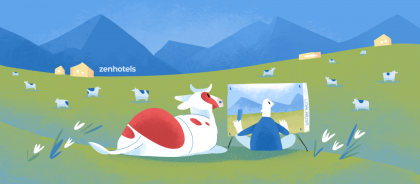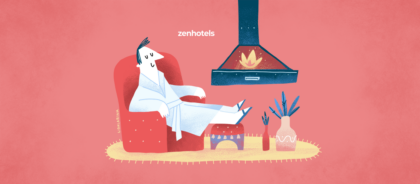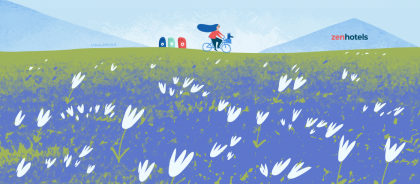Zurich
Where to stay
The most convenient place is by the railway station and central street Bahnhofstrasse, because from here it’s easy to reach any other part of the city. Hotel accommodation prices start at €100 per night.
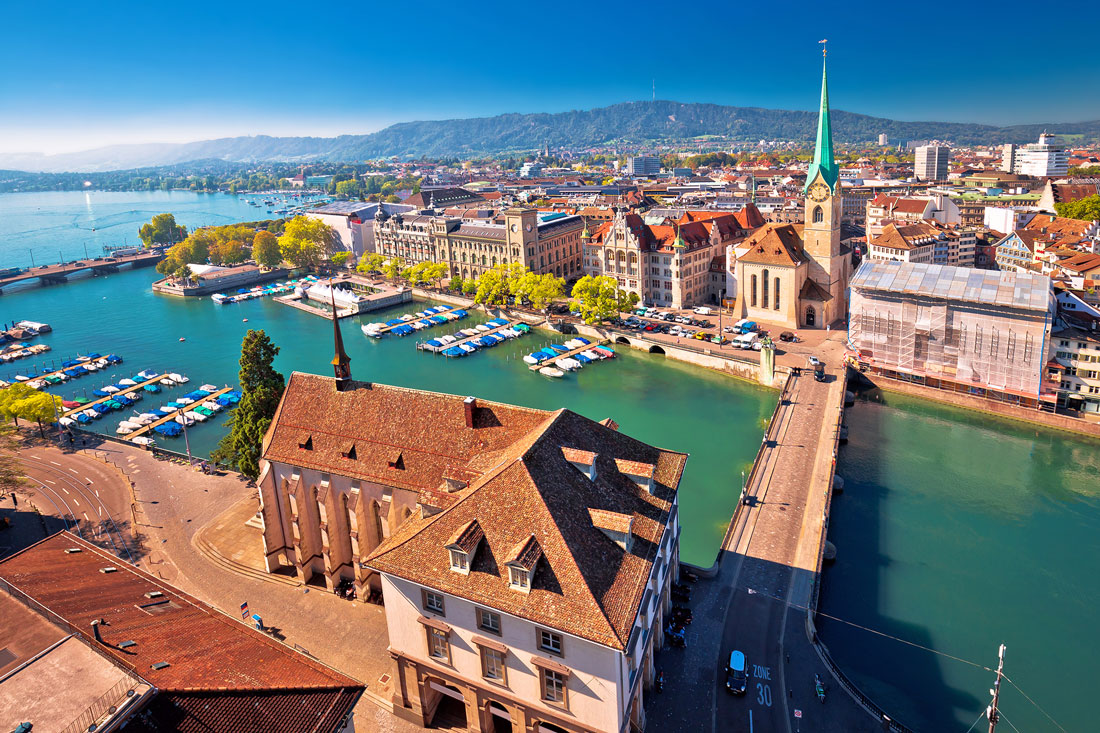
Charming pebbled lanes of the historic center, flower compositions at every step, and the smell of cheese fondue and chocolate – that’s how Zurich appears to visitors.
For budget travellers
- easyHotel Zürich — from €92 per night for two.
- Hotel St. Georges — from €102 per night for two.
For those who enjoy comfort
- Hotel Glockenhof — from €300 per night for two.
- Savoy Baur en Ville — from €375 per night for two.
For those used to living life to the full
- Park Hyatt Zurich — from €525 per night for two.
- Baur au Lac — from €718 per night for two.
How to get around
If you like driving then hiring a car is the easiest solution. But absolutely everything in Switzerland is costly: hiring a car will cost a minimum of €100 per day.
As an alternative, use public transport. Its system is built fairly well, and it works like Swiss clockwork — with incredible precision. The tram network is well developed in Zurich. Make sure you don’t travel without a ticket: the penalty for travelling without one is around €96. Anyway, it’s convenient to walk around Zurich on foot.
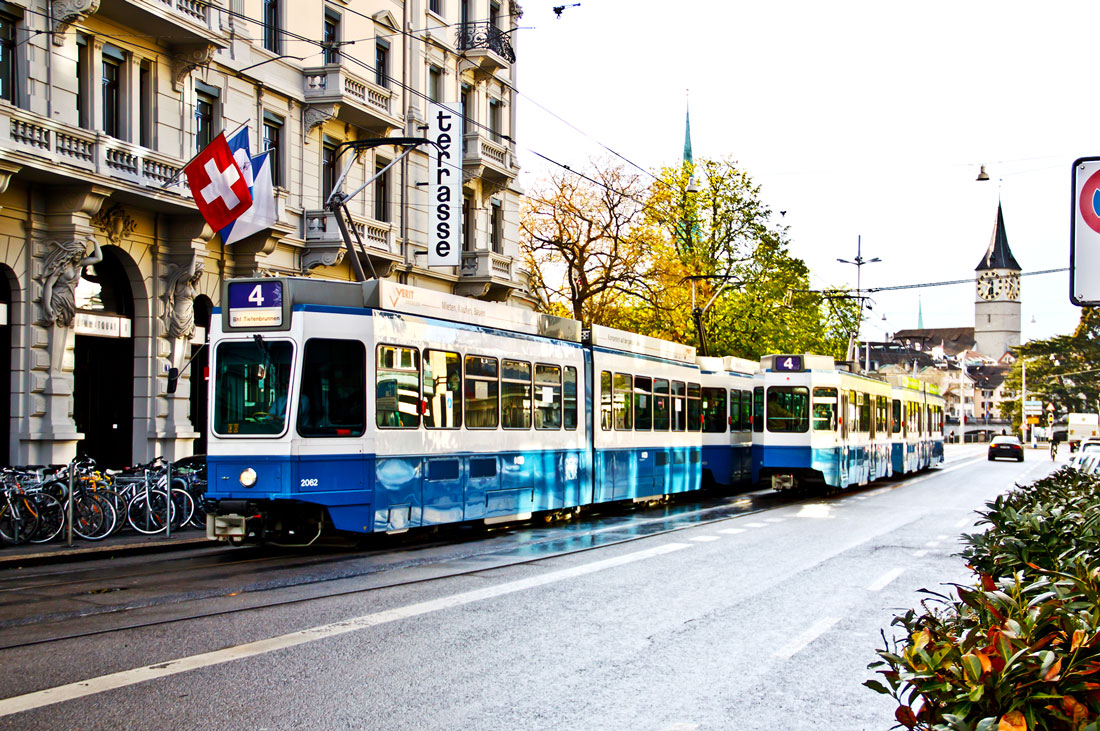
Public transport works like Swiss clockwork — with incredible precision. Photo: nui7711/Shutterstock
An itinerary around the city
The charming pebbled lanes of the historic center, surrounded by little multi-colored buildings, flower compositions at every step and the smell of cheese fondue and chocolate — that’s how Zurich appears to visitors.
The imposing towers of ancient churches in combination with the forged grills of the bridges with the Alps in the background fit in wonderfully with the busy and modern central street full of boutiques and banks.
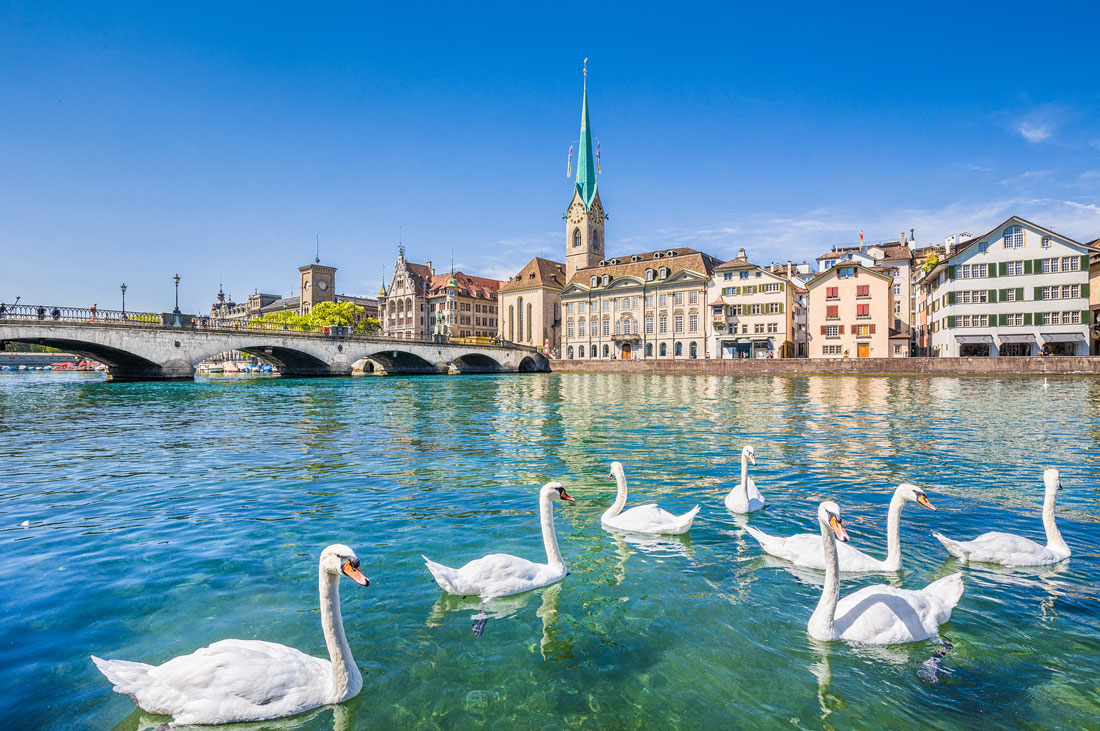
On Burkliplatz Square you can hop on to a tour boat.
A route through the city by foot will last no more than two hours, and it will take in landmarks.
Start with the main street, Bahnhofstrasse. Shop windows with the best watches, delicious smells of chocolate and all sorts of shops — these are all to be found here. The street stretches from the train station to Burkliplatz — a square by Lake Zurich, where you can join a tour boat. You can check its timetable and route on the site. The cost of a trip starts at €1. You cannot drive along Bahnhofstrasse by car — the only transport available is the tram.
Hunting for chocolate
If you’re looking for Swiss chocolate, head to the Lindt and Teuscher boutiques. The latter is admittedly far more expensive, but its chocolate is considered among the country’s best. For example, 100 grams of chocolate will cost around €12, while a set of 16 truffles will cost about €36.
Make sure to visit Paradeplatz — or parade square. This is where people gather during carnivals, such as the Zurich one held in the city every spring. This square also hosts the city transport hub of the same name, as well as the legendary confectionary Sprüngli. It’s renowned for its famous Luxemburgerli treats. They resemble French macaroons, but are smaller with a light and fluffy filling.
Altstadt is the oldest part of Zurich. You get here by turning off Bahnhofstrasse. The narrow lanes, multi-colored buildings and charming little balconies with geraniums won’t leave you indifferent.
Along the way, take a look at St Peter’s Church. It is a picturesque building with a pointed roof like a house of cards. The church is famous for having a clock tower with the largest dial in Europe. Its diameter is 8.7 meters and the minute hand is nearly four meters long.
Then climb up to Lindenhof. This is a platform and park on a hill from where you can admire a great view of the city, lake and Alps, and hold a picnic. At one time it was a customs center out of which Zurich grew, hence Lindenhof is its true heart.
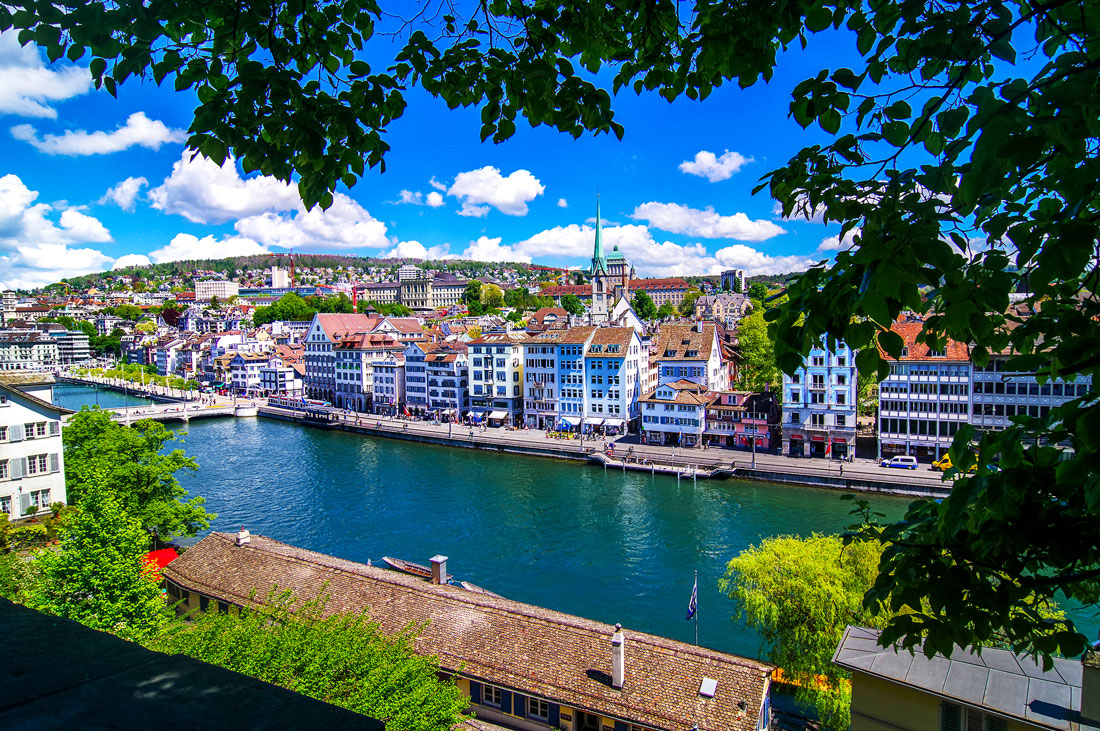
From Lindenhof you can admire a great view of the city, lake and Alps. Photo: Urs Hauenstein/Shutterstock
Then head for Niederdorfstrasse — the most touristy and lively street of the city, with lots of shops, cafes, hotels and other entertainment. Here you can buy souvenirs or hang out in a bar. If you want to eat lunch, take a look in Adler Swiss Chuchi. It has a great selection of traditional Swiss cuisine — for example, fondue and raclette.
The former consists of different sorts of melted cheese in which you dip dried bread. Raclette is similar to fondue, but a special type of cheese is used for it. It is first warmed up, then scraped off the plate, and then placed in strips on bread, boiled potato or pickled vegetables. This restaurant is very popular in the city, so it’s best to book a table in advance on the site.
Walking through the old city, you may pass a building located at Speigelgasse 14. Vladimir Lenin once rented an apartment here — a plaque is attached to it commemorating this event. Your next step should be the tower of Grossmünster.
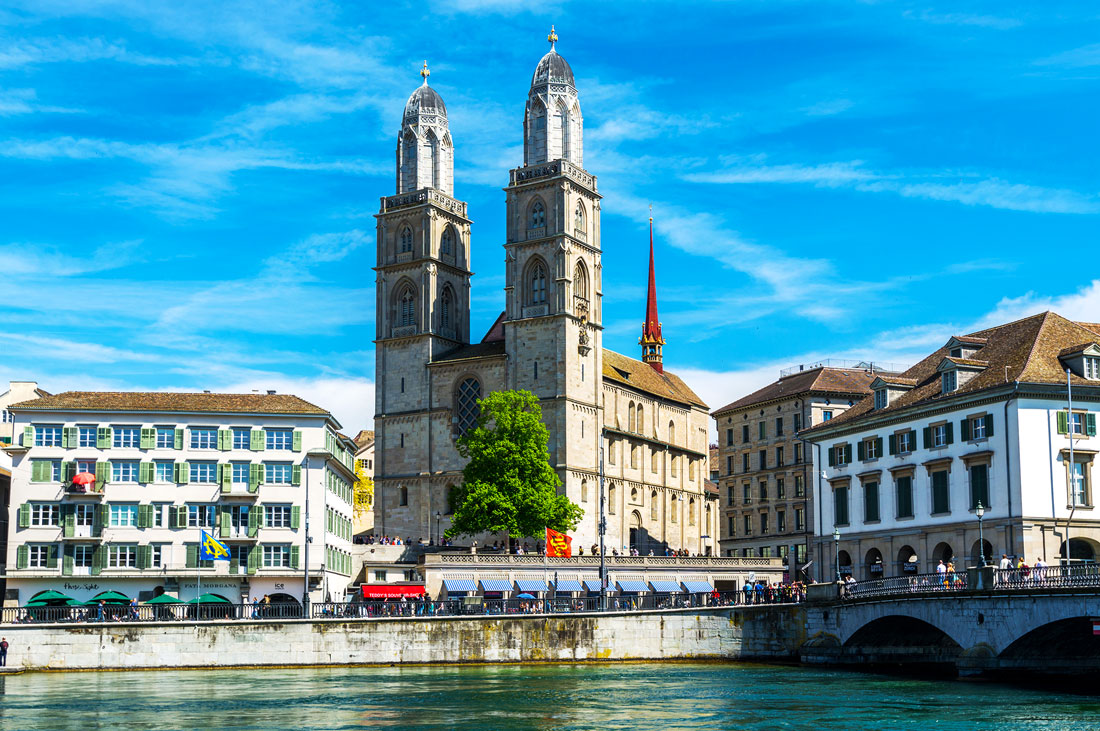
Grossmünster is the main cathedral and a symbol of Zurich. Photo: Victor Jiang/Shutterstock
At one time a monastery, today it is one of the symbols of the city and its main cathedral. One of its towers contains a viewing platform. You can only access it on foot, and entry costs €3.60. The view that awaits you at the top is worth the effort.
You can take a stroll from the tower to Lake Zurich, where you can feed the swans. On the way, you will encounter the famous Café Odéon built in 1911. It remains one of the city’s most popular places. Famous people to have visited it include Stefan Zweig, Hans Arp, William Somerset Maugham, Erich Maria Remarque, Klaus Mann, Franz Lehár, Arturo Toscanini, James Joyce, Albert Einstein, Vladimir Lenin and others.
Lake Zurich begins at Bellevueplatz — another transport hub. You can walk along the bank and feed the swans at the lakeside — they have quite a penchant for fresh baguette.
Another famous cathedral and a rival to Grossmünster is the former convent for noble maidens Fraumünster Church. Definitely take a look inside, as the stained glass windows were all created by Marc Chagall. We recommend getting here in the morning, when the rays of the sun cut through the gaudy stained glass, enhancing its beauty.
A day in the mountains
If you have the time and want to admire the panoramic view of the city, Alps and lake, ascend Uetliberg mountain. You can get there from the railway on train number S10 to Uetliberg station. The trains leave around every half hour and it takes about 25 minutes to reach the mountain top. A return ticket costs around €16.
If you continue up the path a little further you will come across a viewing platform with a stunning view. And it also contains a hotel and a restaurant where you can meet the sunset over dinner. If you want to climb even higher there is a viewing tower.
Trips out of Zurich
After visiting the Swiss capital, head to the main railway station: Zurich’s surrounding area has lots of interesting places to see. You can reach any city by train in 30—60 minutes. You can buy tickets and view the timetable and route on the site of Swiss Federal Railways.
Rhine Falls
This waterfall is located right by the border with Germany. You can get there from Zurich in 40 minutes by car or by train to the city of Schaffhausen, and then the local train to Neuhausen am Rheinfall. A one-way ticket costs around €11.50.
Rhine Falls are the largest horizontal waterfall in Europe, with a length of 150 meters and a height of 23 meters. The streams of water bubble and slip down steps, creating the feeling of a rampaging element. You can stand on the edge, catch the foam and feel this power.
Or you can even take a boat trip, which for €6.40 will bring you to the overhang in the center of the waterfall! Entry to the viewing platform costs €5.60 per person. You can read detailed information on the site.
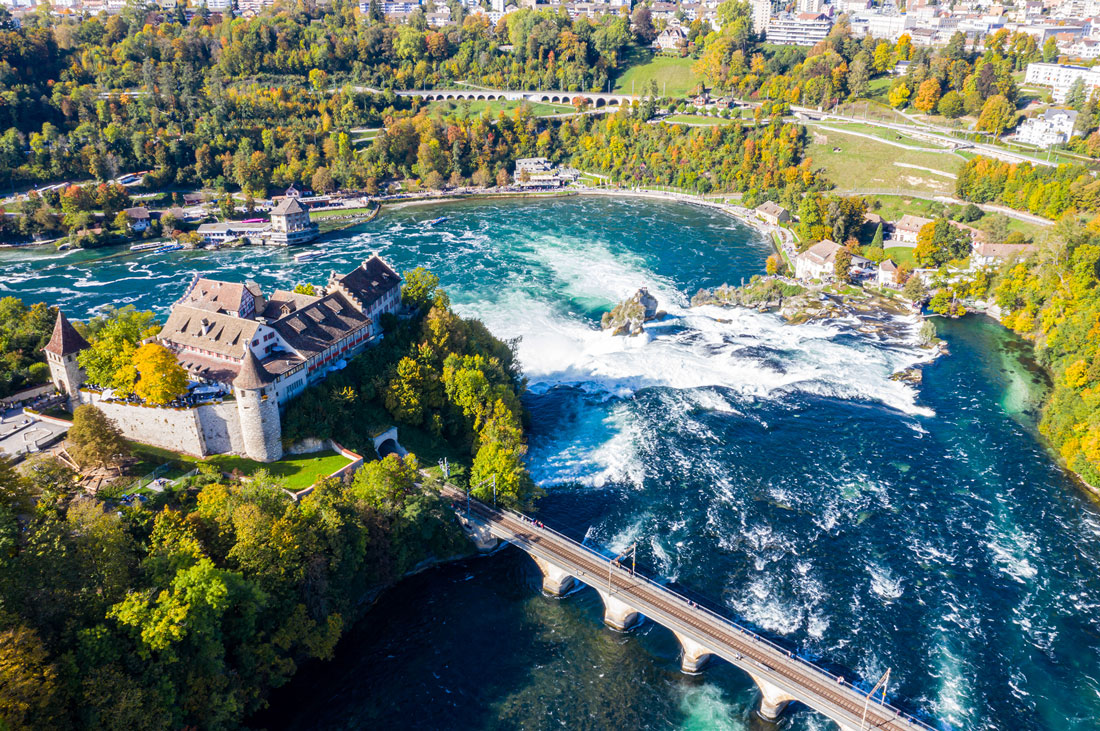
Rhine Falls are the largest horizontal waterfall in Europe.
Lucerne
Lucerne is often named the most beautiful city of Switzerland — don’t miss the chance to visit it. All the more so, as you can get there from Zurich by car in just 40 minutes, or take the train to Luzern station, which is a one-hour journey. A one-way ticket costs around €12.60.
The Kapellbrücke is the oldest wooden bridge in Europe, dating to 1333 and with a length of 170 meters. Under its roof you will find over 100 paintings by Hans Heinrich Wägmann portraying important moments from Swiss history. Spreuer Bridge — “mill” bridge — is a bit smaller and younger, built in 1408. Paintings also decorate it under its roof, on the subject of the Dance of Death by the artist Kaspar Meglinger combined with poetry of Muller.
Hofkirche St. Leodegar with its sharp-roofed towers is the most important church in the city. You can hear organ concerts here in summer. Meanwhile, the oldest church in the city — Saint Peter’s — is located on Kapellplatz. It dates all the way back to 1178. Another interesting square is Hirschenplatz. Goethe once stayed in the nearby Goldener Adler hotel.
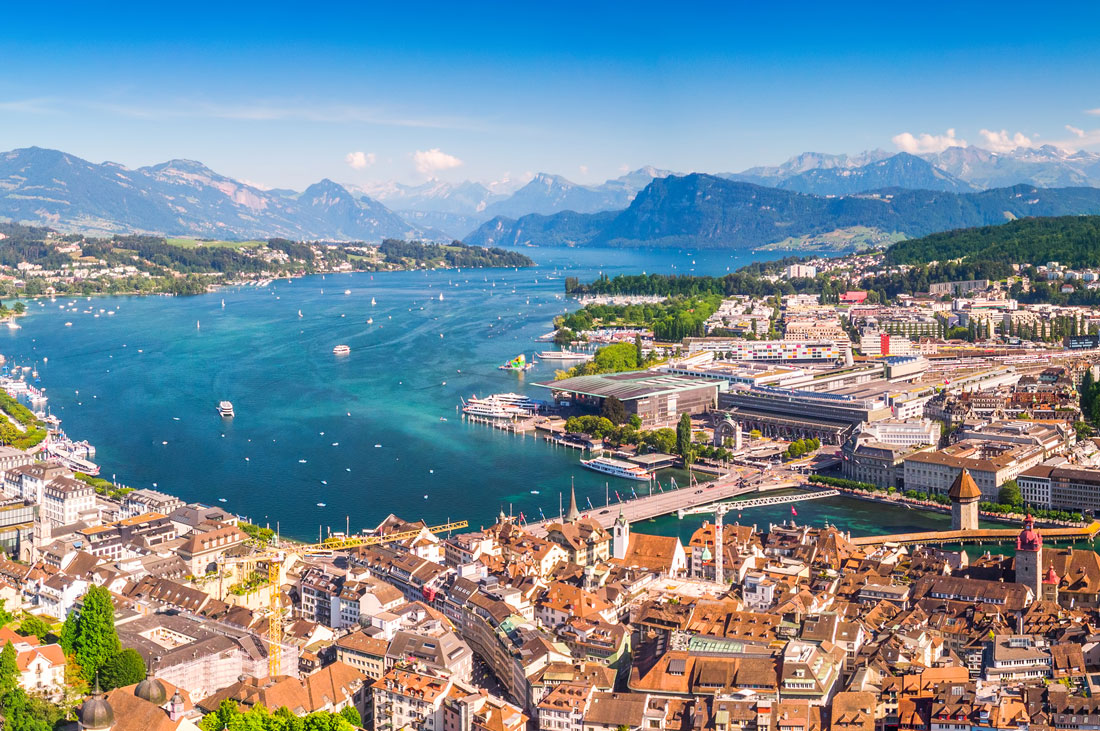
Lucerne is often named the most beautiful city of Switzerland.
One of the most impressive locations of the city is the statue of the dying lion, carved into the cliff face. The monument symbolizes the bravery of the Swiss Guards who were massacred when defending the palace of the Tuileries from attack during the French Revolution. During his European tour Mark Twain named this monument the saddest and most touching stone carving in the world.
Make sure to get to Museggmauer — part of a medieval wall with a length of 870 meters built around 1400. Eight towers have survived, and you can climb up three of them. From the top you get an amazing view of the city, and the wall itself is surrounded by green Swiss meadows.
Basel
This is the third-largest city in Switzerland after Geneva and Zurich. It’s known as an industrial center, the capital of the best museums and the organizer of the largest Swiss carnival, which is just as interesting as Venice’s. The country’s first university was founded in Basel and Erasmus once taught there.
You can reach Basel from Zurich by car in an hour and a half, or by train to Basel station in one hour and 15 minutes. A one-way ticket costs around 17 francs.
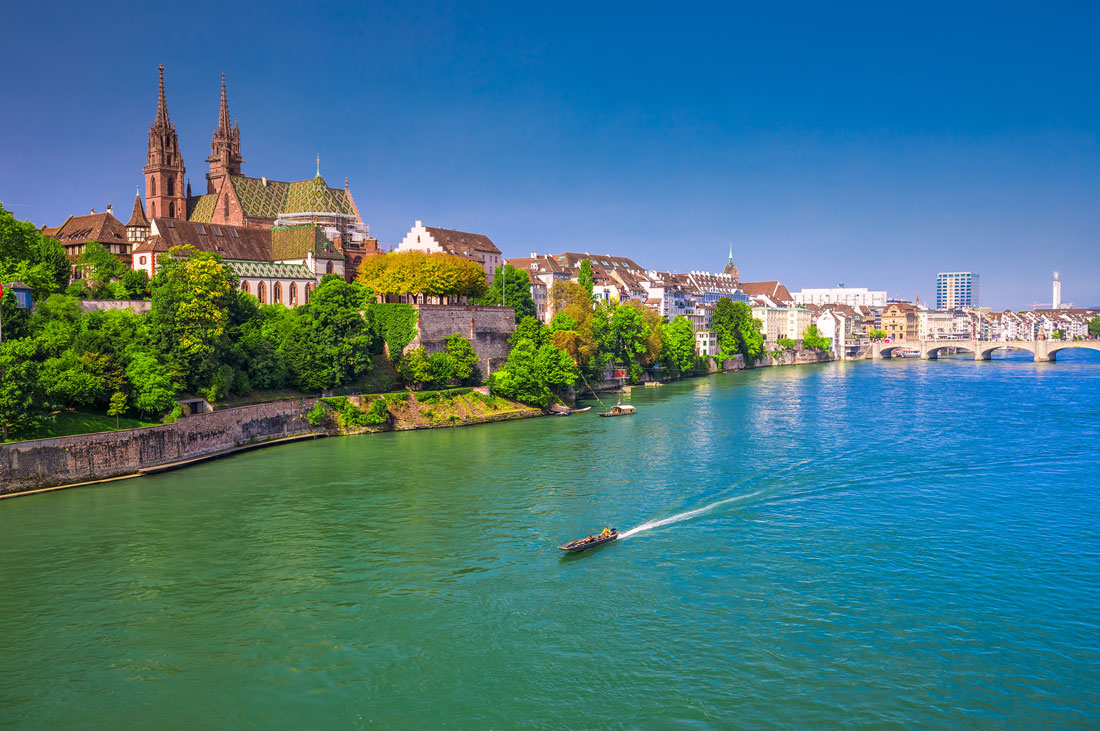
Basel is known as an industrial center, the capital of the best museums and the organizer of the largest Swiss carnival, which is just as interesting as Venice’s.
As you would expect from a cultural center, it’s a true city of museums. Visit, for example, Puppenhausmuseum. It’s one of the largest museums of modern puppets in Europe and can boast an interesting collection. Little puppet-houses, marionettes, soft toys and more — this collection will be of interest not only to children, but to adults as well. A ticket costs 7 francs. You can find detailed information on the official site.
If you like walking, then begin exploring the city from Saint Elizabeth’s Church with pointy-roofed towers, facades resembling lace, and ribbed brick vaults. This is the largest Gothic church in the country.
Go all the way to Wettsteinbrücke — a bridge over the Rheine which provides a great view of the city. The variation of heights between the banks of the Rheine was a big problem when building it. As a result, the bridge droops at an angle of 2.67%, which gave rise to much criticism of its aesthetic qualities and led to Wettsteinbrücke being nicknamed the crooked bridge.
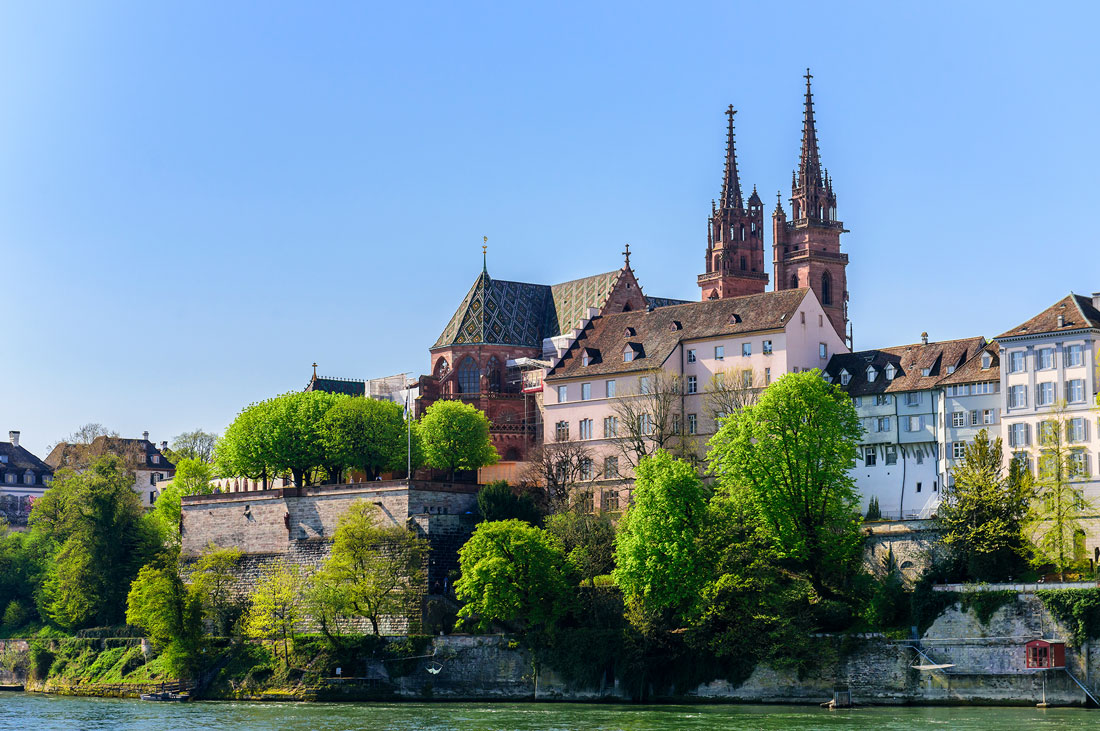
Basel cathedral
Then walk on until you arrive at Minster Cathedral, built in the 11th century. This is where Erasmus is buried. For 4 francs you can climb up 62 meters to the viewing point in the tower.
In fact, it was probably the most frightening climb I undertook in my life, due to the narrow, steep and twisting steps, the lack of protective barriers and the bells that ring in your ears. However, the view you get at the top is worth the biggest of frights.
Other interesting sites include the eccentric Carnival Fountain, which consists of mechanisms, gear wheels and even ladles that re-pour the water, St.Martin the oldest church in Basel, and St. Peter’s Square with its fairs and flea markets and its eponymous church.
You might also go the city’s ancient gates. The city was once surrounded by a wall with a multitude of towers and seven gates for vehicles. However, they soon lost their importance and started to limit the city’s growth, so it was decided to pull the city walls down. They only left the three most attractive towers, ones which didn’t resemble each other: Spalentor Gate, the Tower of St. Johann and the Tower of St. Alban.
Panoramic trains of Switzerland
Panoramic trains are a special type of transport in Switzerland. These are railcars with huge window that travel slowly through the Alps. The trip is accompanied by stories about the places the train passes. You can use this form of transport to get to somewhere specific, or simply to enjoy a ride along a tourist route. Look at the options on the site.
Liechtenstein
This tiny independent principality located between Switzerland and Austria is quite near Zurich. So why not visit one more country during a trip to German-speaking Switzerland? All the more so as if you are spending francs rather than Euros during your trip you won’t even have to change any more currency. Swiss francs are the currency in Liechtenstein.
You can reach this tiny state from Zurich in one hour 40 minutes by car. Or take a train, but you have to change on to a bus, as Liechtenstein has no railway tracks. You need to take the train to the nearest station to the country’s border, Sargans, and then hop on to bus number 12Е or 11. The journey will take around two hours. A one-way ticket will cost around 20—30 francs.
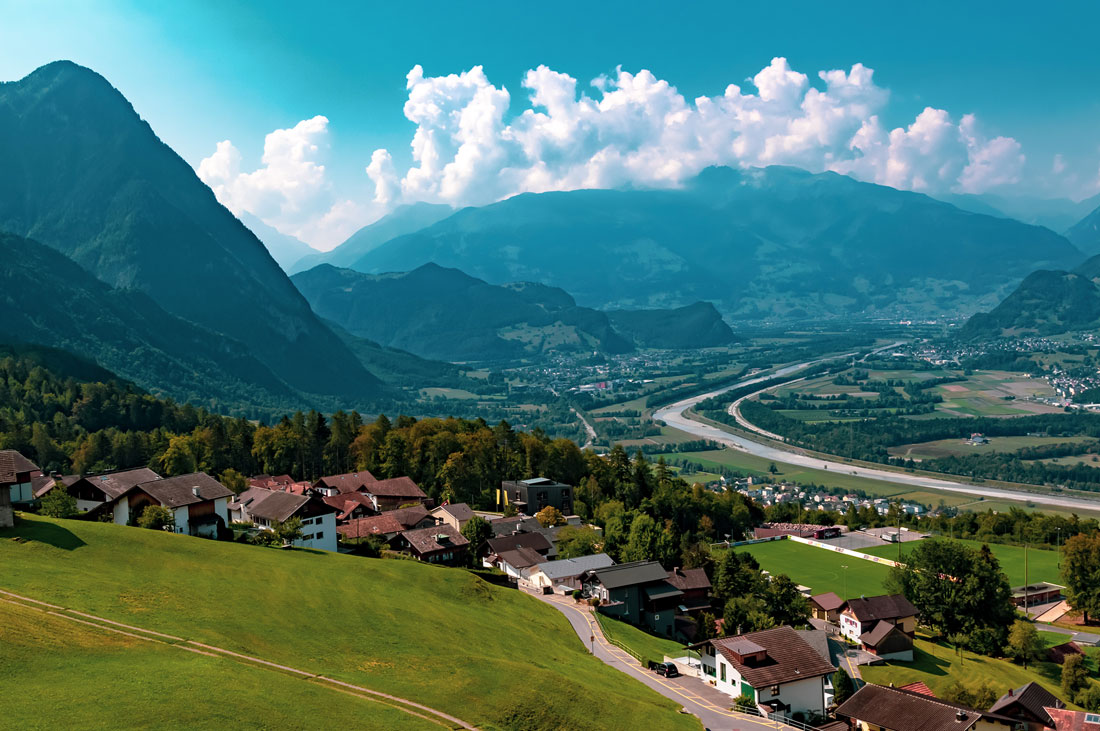
Liechtenstein and Switzerland are very similar in appearance: the same colored little houses with murals, green meadows and the Alps.
You can get from Zurich to Liechtenstein in one hour 40 minutes by car.
A convenient way to see all the main tourist sites is to take the tourist train. Citytrain takes you on a 35 minute ride and costs around 10.50 francs. You can check the timetable and information on the official site.
The main tourist lane in the capital is Stadle. The main cathedral is St Florin’s. Nearby you will find the Postage Stamps Museum with free entry. Here you can send a postcard home and buy a stamp of the principality. Check information on the official site.
Then walk to Schloss Vaduz. This is the permanent residence of the prince of Liechtenstein — you can only see it from the outside. Another interesting place is Burg Gutenberg. It’s a medieval fortress of the XVI—XVII centuries that rises above the city on a 70-meter hill. The internal courtyard houses a rose garden and a chapel. You may go inside during a festival or theatrical performance.
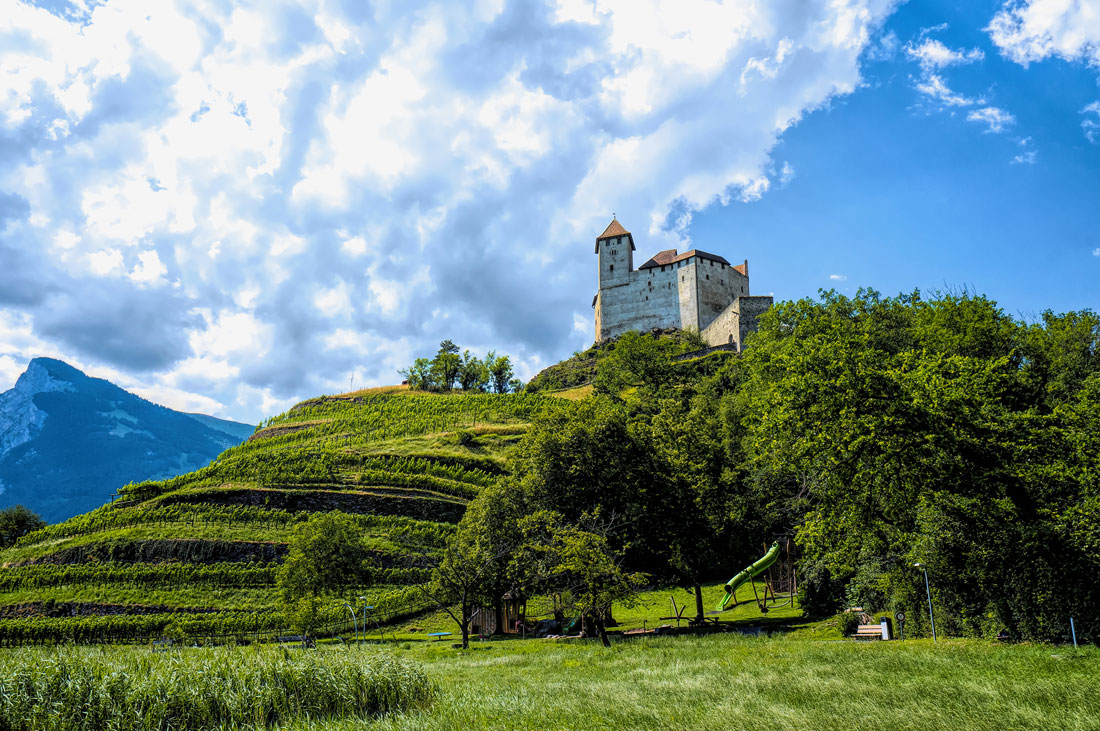
Burg Gutenberg
You will be sure to take home memories of Red House — a red building which since 1807 has belonged to the family of the Liechtenstein artist, sculptor and architect Egon Rheinberger. Another interesting piece of architecture is the Government House, a building dating to the early 20th century, which serves as Liechtenstein’s most recognizable site.
The village of Bergün
Hidden by the Albula Pass, the village of Bergün attracts tourists with its picturesque landscapes. Its eponymous railway line retains the same appearance that it had 100 years ago.
To get here from Zurich takes around 2 hours by car or 2 and a half by train to Bergün station. A one-way ticket costs about 32 francs.

Everyone who visits Bergün feels like the hero of an Alpine fairytale.
Multi-colored decorated little homes look like they are doll-houses, while the train travelling between green meadows and the magnificent Alps along the ancient railway line adds to this impression.
In summer, you can take an instructive excursion in the village on the history of the railway line after riding on the train, and in winter ski slopes open here, with sledging tracks the icing on the cake. You can read about what’s available on their site.
Peculiar bans
A law was passed on 29 May 2017 banning the taking of photos in Bergün. It was allowed only from the window of a moving train, from your own land plot or during a wedding. A violation entailed a fine of 5 francs. The funds raised were spent on improving the environment.
The village government cited scientists who proved that photos with beautiful views make people unhappy, as not everybody has the opportunity to come and see Bergün with their own eyes.
Actually, though, it turned out that this was just a marketing ploy. Thanks to the ban, the government attracted a higher number of tourists to the area. As soon as the news emerged 50 million people around the world viewed photos of this charming little Swiss village. The ban became a hot topic on Twitter, and yet the government paid nothing for this advertising to tourists.
When you arrive in Switzerland, you immediately feel like you are in an ideal postcard scene. Famous cows with bells on tended bright green meadows, ancient arched bridges with trains running along them, charming little houses with decorated facades, lakes with snow-white swans, and the Alps. It’s like being in a fairytale. After visiting you will definitely want to return.

